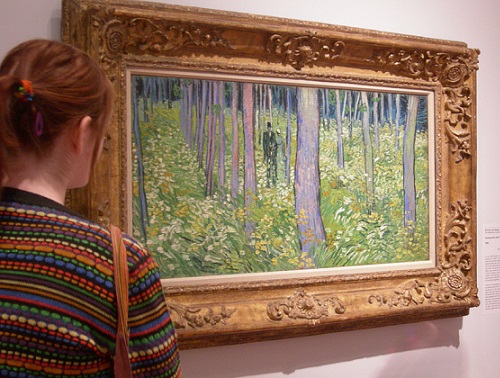8 Ways to Train the Art Appreciator in You
I’ve developed this guide for the intimidated among us. Enjoy!
1. Allow your reactions to guide you. I am not an art student. I never was. I didn’t “get it” when I studied it in college. As a result, all I have to go on are my immediate impressions of art. So do you…and you can love art with no teaching at all. Don’t pick paintings to appreciate… look for paintings that you like and start there.
2. If possible, the place to begin looking at art is in an art museum. Books are fine, but there is nothing like seeing a painting up close. The textures are totally lost in books. And to realize that Ruebens or Matisse or O’Keefe stood where I am standing at some point in history takes my breath away every time. So go to a museum—any one will do because there is always at least one painting worth seeing.
3. Before you enter the museum proper, buy the picture postcard pack for that museum in the gift shop. This is especially helpful with kids. Flip through it before you enter the galleries. Note the paintings that you want to see and then go straight to them. Don’t stop and meander, trying to appreciate paintings that you don’t like, understand, or care about. Art appreciation takes energy so feel free to conserve yours for the ones you think are gorgeous, terrifying, creepy, or mesmerizing!
4. Beg, borrow (we did both) or steal Sister Wendy – The Complete Collection (Story of Painting / Grand Tour / Odyssey / Pains of Glass) (affiliate link). It is so enjoyable and she has such passion for art that you can’t help falling in love with her and the paintings.
5. When you find a painting you like, sit in front of it for a length of time. Really look. Look at the colors. Look at the corners. What’s in them? Focus on the actions of the subjects. Look at the directions the faces are looking, and who’s looking at whom and what they are possibly saying. Look at the position of the sky and how much canvas it takes up. All? Some? Very little? Look at the interaction of light and shadow. Notice the style and size of brush strokes. These things were all deliberately done for effect. That’s why it’s worth stopping to notice.
6. Put up prints of famous paintings that you can’t see in person in your house. Put up prints of your favorites from your local museum in your house too.
7. When you like a painting, write about it. I have so enjoyed Charlotte Mason’s approach to art appreciation. I keep my comments about paintings on scraps of paper, in notebooks, and on the backs of programs. When I write/narrate, I find that I “see” more than I knew was there. And then I can recall the painting in my memory from re-reading my writing.
8. If you are someone who doesn’t love art but thinks you should, I strongly recommend going to an art museum either alone or with a friend who loves art, on your first trip. Don’t take your kids with you. Learn about whether or not there is anything in art that attracts you, alone, without education as your objective. If it turns out there is, then you can share that with your kids.


















